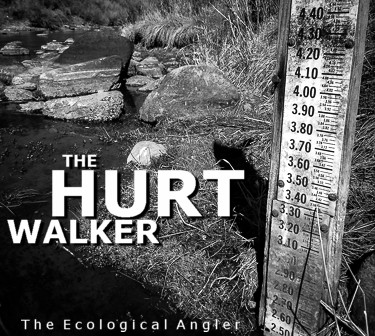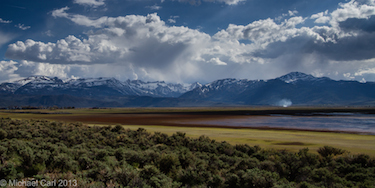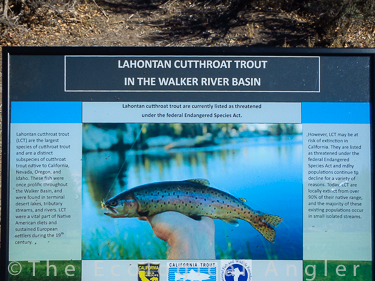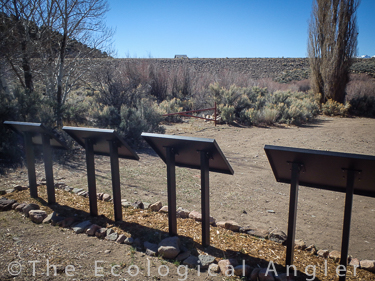East Walker River
The East Fork of the Walker from Bridgeport Dam to Nevada State Line is a year round fishery. Use only barbless hooks and the fishing season from November 16 through the last Friday in April is Zero-Limit.
The Drought Puts a Hurt on the Walker

Drought isn't just visible in the low Spring flows and the paper thin sheet of snow over the Sierras, but I could hear it around Mono County. In the small town of Walker, I heard a man say at the gas-station: I guess we won't get to shower until next Winter.

While hanging out at Ted's Automative waiting for my '96 Chevy Silverado to get a brake-line replaced, a young woman who brought pizza for the mechanics said to me: The Eastern Sierras are too depend on water based activities (e.g., skiing and fishing). We need to plan events that don't need water to get folks over here.

As I stopped at the stretch of the East Fork below Bridgeport Reservior in early April, my mind couldn't equate the flows (roughly 20 cfs) with the time of year. The productive runs were extremely shallow. And worse, aquatic plants were taking hold covering the stream bed like a soft, green blanket. Much higher flows are definitely needed, but will they come?

Another far less threatening change to the Miracle Mile - new signage at the upper parking lot. The four signs act as reminders that the entire Walker River Basin was home to a large population of Lahontan cutthroat. With Bridgeport Reservoir Dam stretching across the East Fork in the background, you don't have to look far to understand how things started going bad for these native fish.
The Drought of 1987-1994
In April of 1987 the snow water content of the Walker River Basin was recorded at only 46 percent of normal for this time of year, signaling the beginning of a drought period which lasted through 1994 (eight years). In the following year, responsing to farmers' desperate need for irrigation water, WRID drained Bridgeport Reservoir, flushing warm water and considerable quantities of sediment from the bottom of the reservoir into the East Walker River, subsequently causing an extensive fish kill downstream.
In response to the draining of Bridgeport Reservoir by WRID, the California Trout, Inc., a sport-fishing association, filed a complaint with the California SWRCB claiming that WRID's draining of the reservoir violated several state fish protective statutes and caused a loss of fisheries in the reservoir and downstream (see entry under February 5, 1963). When subsequent negotiations between the California Department of Fish and Game and WRID proved fruitless, the SWRCB moved ahead with an investigation and eventual water rights hearing. Two years later, with the participation of WRID, California Trout, Inc., and the Lahontan Regional Water Quality Control Board, the California SWRCB completed its hearing process for the draining of Bridgeport Reservoir in the summer of 1988 by WRID. SWRCB amended WRID's license for water storage in Bridgeport Reservoir, requiring minimum downstream flows and minimum reservoir pool requirements.
In 1963,an agreement between the California Department of Fish and Game and WRID allowed WRID to enlarge and modify Bridgeport Reservoir and Dam so long as WRID would maintain a minimum pool in the reservoir of 1,500 acre-feet for the protection of fish life, except during defined years when WRID would maintain a minimum pool of at least 300 acre-feet. The agreement also specified minimum streamflow releases, generally the lesser of 50 cfs or natural inflow during the irrigation season and 8 cfs the rest of the year, subject to dry year provisions.

